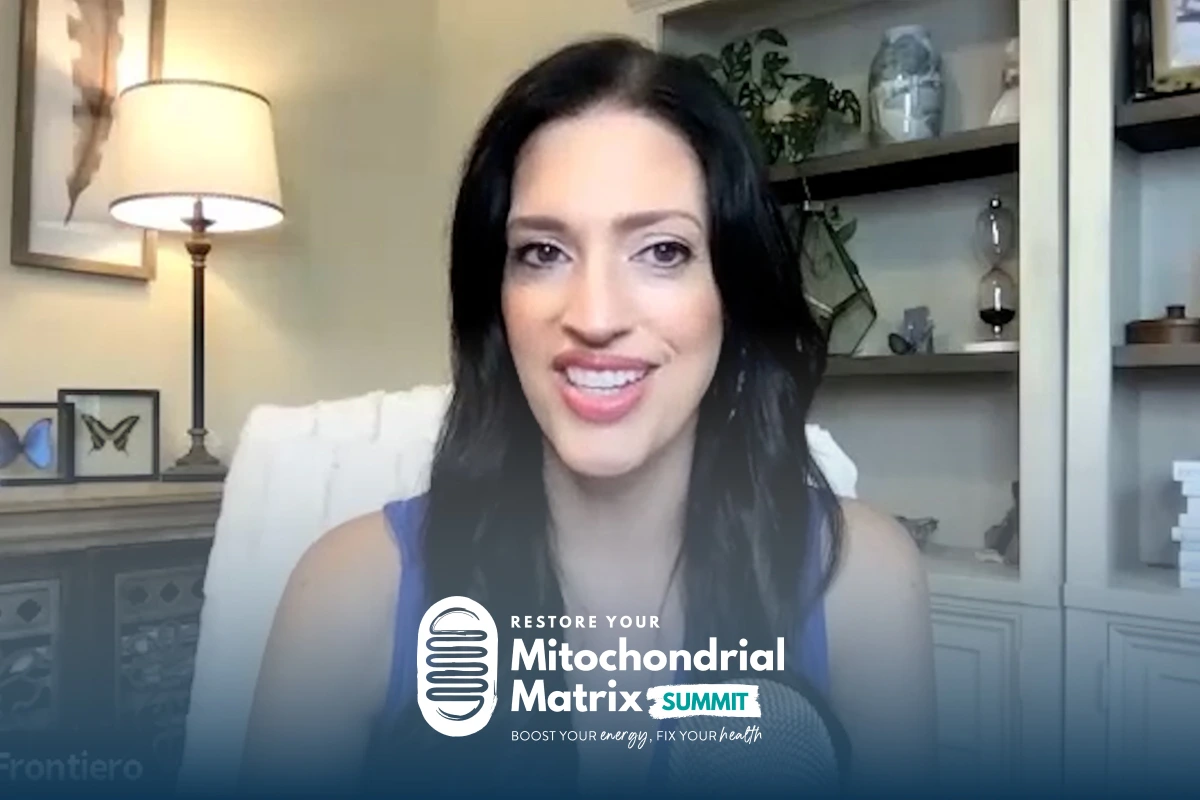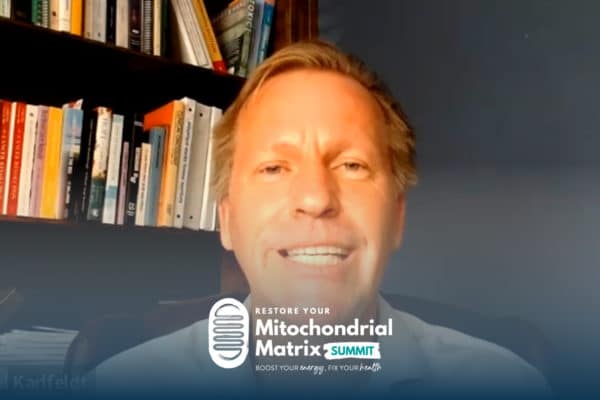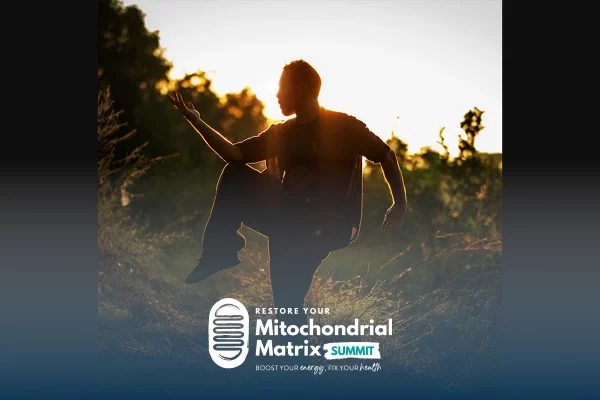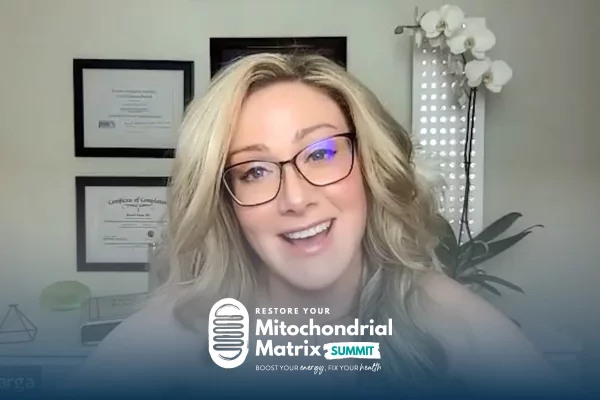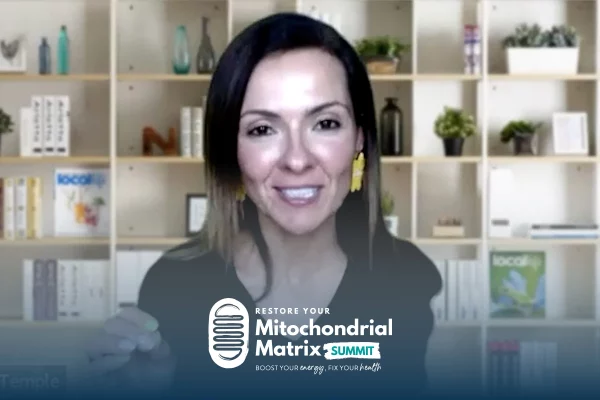Join the discussion below
- Explain the difference between a ‘positive stressor’ and a ‘negative stressor’ and understand why you should have ‘good stress’ in our life every single day
- Learn how to heal your cells to reverse chronic disease, inflammation, and aging
- Explore how simple it is to add simple daily practices into your routine.
Laura Frontiero, FNP-BC
Welcome back to the mitochondria conversation. I’m your host, Laura Frontiero And in this talk, I’m going to be covering the seven positive stressors missing in your daily life that build your energy and heal your cells. And I know that sounds crazy, but I’m talking about positive stressors. And I’m joined by Daniela Giangiorgi. She’s my lead coach and right hand at Bio Radiant health. Hi, Daniela. Welcome back.
Daniela Giangiorgi
Hi, Laura. Hi everyone.
Laura Frontiero, FNP-BC
I’m so glad you’re here. Let’s make sure our audience knows exactly who you are. You’re a mindset empowerment health coach, who also is a Pilates instructor with a muscle activation technique certification. And I love having you as a part of these conversations because you understand the importance of cellular health really. At age 41, you were diagnosed with breast cancer and that interrupted the breastfeeding of your one year old baby boy. And if anyone understands the power of healing and why I stand for restoring mitochondria function and gut health, Daniela, it’s you. So thank you. Welcome. And you can always help me facilitate these discussions so beautifully. So thank you for that.
Daniela Giangiorgi
Oh, thank you, Laura. Yeah, I do inherently through my own life experience really know what this is all about and I’m so forever thankful that I met you because aside from the breast cancer, you know, when I met you, I was going through a whole nother thing that probably would’ve created havoc on my historical breast cancer, but thankfully I met you and you helped me reheal with the current things that were going on. And that was depression, that was anxiety, that was low energy. That was brain fog. And I did really not know what to attribute to. And you were savvy and you saw this in me and you said, I think this is what’s going on. I think there’s issues with your gut health and whatnot. Let’s do some testing and because of your level of integrity because I know you as a human being, I know your heart, I know your intelligence, I know your profession. I said, great, let’s go for it. And sure enough, we found a lot of dysfunction going on and you gave me a protocol that literally for me, it was incredibly short. Two weeks later, my life changed. And when I say that on paper, it was the same. I had the same house, I had the same children, same husband, same job. However, my experience was a complete shift. I looked at myself in the mirror. I enjoyed being with myself again, I recognized who the woman was and I feel not necessarily, more importantly, but so importantly, my children got their mom back. So it was really been a priceless experience for me.
Laura Frontiero, FNP-BC
Thank you so much for sharing that and I remember your journey so well and it was amazing to see you come out of it in two weeks and, you know, it can be that fast if we absolutely can pinpoint what’s going on and create a protocol that is tailored to your biochemical individuality, your needs.
Daniela Giangiorgi
Yeah, and it was. Yeah, it was. And so, Laura, you’ve been in the health industry for a long time. In fact, for over 20 years now, you’ve been a nurse practitioner and you specialized in preventative and functional medicine. You’ve gotten the opportunity to work closely with and study with a long list of today’s most respected interventional natural health oriented doctors and experts. And now you’re in a situation where you’ve built Bio Radiance Health, and you are helping people everyday high performers like you and I and could be athletes. It could be a mom. These high performing people, you’ve helped them reclaim their energy, their brain stamina and their productivity. So in turn, you’ve become this trusted resource for people wanting to build back their health so that their bodies can keep up with their ambition.
Because so oftentimes we’re mismatched and you’ve just brought everybody right up so that they can reach their maximum potential. You are a go-to source for gut health, for energy and for brain health. And in your programs, you really do help people reach their health goals. by teaching, I love this, bio hacking strategies, who does not wanna hack, right? That help increase that human performance. And just for the everyday person who wants to function at their highest level. So in other words, your strategies are just as helpful at increasing our daily stamina as increasing like stamina for a competitive athlete or extreme performance, it doesn’t matter. What matters is you wanting to reach your maximum potential? So can you share with us this concept of, this is a great word, hormesis, which actually is a stressor that helps us rather than hurts us.
Laura Frontiero, FNP-BC
Yes. And hormesis, you know, is probably one of the ultimate things that we can do. The things that we can do to create hormesis in our body, the ultimate bio hacks, or I like to call ’em bio optimizing or bio elevating tricks to create hormesis in the body. So basically hormesis is an adaptive response of your cells to a moderate, so not a high level, but a moderate and usually intermittent. So not long lasting, but an intermittent stressor. And the basic con concept is that small amounts or small doses of stressors to the body may actually be good for you and protect you from larger amounts of stressors. So I’m gonna get into these different types, but just while I’m illustrating this, I just wanna use one of them, which is the concept of cryotherapy. So people viewing maybe aware that you can go into a full body cryo chamber for-
Daniela Giangiorgi
And can you tell people what cryotherapy is?
Laura Frontiero, FNP-BC
Yes, it’s cold therapy. So a cryo chamber is very, very, very cold and you go into it, it’s like a super freeze. And so you go into this, you know, negative, gosh, it’s off the top of my head, I can’t remember. It’s like negative 30, negative 40s, maybe even lower than that. I mean, it’s very, very, very cold. And so you go into this chamber and you’re stand in it for, you know, three minutes or so like probably a maximum five. And you just get this blast of freezing. Now in a small dose, that is actually good for us. But if you stayed in there, you would freeze your cells and you would die. And that would be very bad to stay in there. So that’s just to illustrate the concept of a healthy little dose of stress that given in a big way could be harmful. So hormesis is actually proof that healthy stress does exist. And those intermittent doses of hormetic stressors like cold exposure, like I just explained, or you can do heat exposure or things like intermittent fasting and intense exercise. They can stimulate cellular pathways that actually support your overall health. So from a mitochondrial perspective, when your cells experience the mild stressor, not the long term stressor, but the mild short term stressor, it stimulates mitophagy and mitogenesis. So let’s break down what those words mean.
Daniela Giangiorgi
Yes, please.
Laura Frontiero, FNP-BC
So mitophagy is elimination of mitochondria that are damaged and dysfunctional and mitogenesis is regenerating more mitochondria from the healthy, stronger ones. So it’s actually kind of reproducing. So mitogenesis, reproducing generating, mitophagy, eliminating. And this process has to happen to prevent the accumulation of old and damaged mitochondria that cause oxidative stress. So many of us know that oxidative stress is bad. It ages us, we find high levels of oxidative stress in people with heart disease and cancer and chronic conditions, Parkinson’s, Alzheimer’s. And so you wanna reduce the amount of that. And also the process helps with low energy levels. So it helps to boost up energy. It helps with metabolic disease, it helps for the creation of new mitochondria. Like I just mentioned mitogenesis, and it really stimulates cells to clean house. So you go in and you dust everything off and you vacuum the floors and you get rid of waste and malfunctioning cells. So clean your body’s house, so to speak, when cells are no longer functioning, they have to be recycled. We have to get rid of them, you recycle through your cells. Every cell in your body is regenerated at some point. And if they’re hanging around, it’s just slowing everything down. So these positive stressors help your cells and ultimately your body become more resilient. So let’s think about that word, resiliency.
Yeah. It’s so key. I mean, one of the key factors to surviving, you know, the changes that occur in our environment and on earth is resiliency. And that could be emotional resiliency, physical resiliency, but we know that that’s a factor in survivors. They’re resilient, people who survive anything have this resiliency. So there’s seven positive stressors that we’re gonna be briefly covering today. One of ’em I already did, the cold and our speakers on the summit go into great detail on several of these. So be sure to catch the talks, especially Ari Whittens talk on hormesis, but the seven are, and there’s more than this, but these are the seven that are most common. And so that’s intermittent fasting, and I did a fantastic talk already on intermittent fasting for you. So catch my talk on food, what to eat and when to eat and the eight foods you should avoid. So we talked deeply about intermittent fasting there, and there’s a couple talks on this summit as well about intermittent fasting, a red light therapy is another one, cold therapy that I just explained. Heat therapy, exercise, dietary phytochemicals, and hypoxia. So, yes, not breathing, which obviously if you’re not breathing for a long period of time, it’s damaging and dangerous to us. And if you’re not breathing for a little bit of time, it’s actually beneficial to us. So that kind of breaks down what hormesis is and the main ones, the main ones that most people will use to biohack their mitochondria.
Daniela Giangiorgi
I love it. I love it. Okay. So let me ask you this, Laura, how do we heal ourselves with these hormetic strategies? So can you give us, for example, an overview on how they work?
Laura Frontiero, FNP-BC
Yes. So I’ll start with intermittent fasting. It’s gonna be a really short talk about it because I already did a huge talk about it. Like I mentioned, go find that talk, but when you’re fasting, damaged mitochondria are purged through autophagy, that’s that, you know, clearing out and cleaning out of the old damaged cells. And you can think of this like your cells sending in a cleaning crew to dust, vacuum, and polish up like I mentioned. Now, the process allows mitochondria to remove the damage debris, accumulative reactive oxygen and nitrogen species and unfolded proteins, which are biologically inactive proteins and fasting reduces oxidative stress byproducts and increases oxygen efficiency while maintaining ATP production, energy production in the cells. Now the next one is regular exercise. So now regular exercise is great, and studies show that you get a 50 to 80% increase in mitochondrial capacity when you exercise with interval training and it does help aid in mitochondria repair and change mitochondrial shape and balance, and mitochondrial cells just become healthier. You get production of new mitochondria, but there’s a difference between movement and exercise. So movement is low intensity without physique related goals. And exercise is high intensity with the goal to build strength muscle and endurance, burn fat, et cetera. So people are always asking me, well, you know, I walk the dog every day.
That’s really movement, and that is not creating autophagy, but if you do short burst of intense exercise, then that will stimulate mitochondrial mitophagy autophagy. So notice there’s a difference. And, of course, we want people to not be couch potatoes. We love it when people are walking their dog every day and moving around, but let’s face it, some of that type of activity doesn’t necessarily translate to exercise and the classic example, and there’s gotta be somebody watching who can relate with this. But the classic example is the letter carrier. Somebody who works for the US Postal Service and walks several miles every day the same route delivering mail, but they’re 50 pounds overweight. So there’s a disconnect there. They’re moving all the time. They’re exercising all the time, but we all have the overweight letter carrier in our neighborhood, right? They’re moving constantly. So something else is the miss. And so it’s not that high intensity with the goal to build strength muscle and endurance. That’s the difference. And I know you’re a Pilates instructor. So what do you have to say about that, Daniela?
Daniela Giangiorgi
Well, I mean, I would say our bodies evolve with us. I have this image of our bodies always trying to conserve energy and whatever we don’t use, we lose because your body’s saying, oh, she doesn’t need X, Y, Z to survive. So I’m not gonna invest my energy in that. And I know this is just a layman’s term way of thinking, but, you know, as we age, you know, our muscles start atrophying and if we don’t use them and fight for them and actually fight to build them, eventually they’re gonna get smaller and less efficient and atrophy eventually. So what we don’t use, we lose. That’s what I would say to that.
Laura Frontiero, FNP-BC
Totally. Yeah, we do. We do. You definitely wanna keep challenging your body and you need to do it. The older you get, the more important this becomes because our hormone levels change, our muscle atrophies, right? So you gotta fight to keep it.
Daniela Giangiorgi
You gotta fight for it. Yeah.
Laura Frontiero, FNP-BC
And part of it is the mitochondria decline that occurs with aging. Yeah. Okay. So a few more that we’ll talk about. So red light therapy, so our viewers may have heard of doing red light extending in front of a panel of red lights to stimulate mitochondria biogenesis, to regenerate mitochondria. So low wavelength of red light therapy is a form of what we call photobiomodulation. The red light goes deep inside the cell, and it increases cellular energy and antioxidant production. And so when you are using a red light and you can’t stand it, you only need usually to do it for about 10 minutes. It would be great if you can do full body red light. I go to this place in my neighborhood that they have cryo a cryotherapy, like I just talked about, they have infrared sauna, red light therapy, and you stand in front of six panels in the front of you and six panels behind you. So it probably stands like 10 feet tall. So you’re fully bathed in this red light front and back, and then do that for 10 minutes and that’s all you need.
It’s not something that has to happen long term, but you can get red lights for your home and you can do red light therapy in like a spa or wellness center kind of situation as well. But basically the benefit is it helps with circadian rhythm balancing and improves sleep. It supports collagen production, it reduces inflammation and pain. It improves skin conditions like like inflammatory skin conditions like psoriasis, for example, it promotes wound healing and tissue repair. It supports hair growth. And so research shows us that mitochondria actually make more energy when they’re exposed to red light and you produce more ATP. So always a great thing. I mentioned cold exposure and cryotherapy. So shivering actually recruits mitochondria to generate heat and even a 30 to 90 second cold blast has been shown to increase mitochondria biogenesis or production. And so you can easily do that in the shower.
Daniela Giangiorgi
So you’ve heard of people taking a cold shower.
Laura Frontiero, FNP-BC
Yeah. Doing hot shower and then alternating with cold shower. I mean, takes nerve to do that right. To stand. It takes nerves, but we’ve heard of cold plunges. You know, that’s really popular right now. You can see it all over social media, people doing ice cold plunge baths, and then those whole body cryo chambers, like I just talked about, you can even do cryo facials where they put cryotherapy on your face to stimulate. Yeah, yeah, for antiaging. And then, you know, this is nothing new, Daniela, professional athletes in their quest, you know, to improve in performance. This is done all the time, professional football players and, you know, baseball players. They do cold therapy as a common strategy to increase their performance. In the locker room, this is what their physical trainers are doing. Okay. Cold dunk for you, you know, stay in their five minutes. All right. Next, get in the sauna, right? Yeah. What do you think they’re doing? They’re hacking they’re mitochondria and this is something that regular people can do. It’s not reserved for athletes as you mentioned. Something else I wanna comment on is heat exposure or sauna bathing. So red light therapy is different than heat. So red light, yes, the lights get warm, but you’re not like super sweating when you’re doing red light therapy. It’s different, it’s more of like a laser therapy kind of a experience, not a heat sauna experience.
Yes. An infrared sauna does have infrared light, but it’s the sweating in the sauna that is so amazing for our mitochondria. So a mild stress signal that triggers cell responses and requires adaptation is what we want. And that happens when you’re heated up, when you’re sweating. And it doesn’t matter if it’s a traditional sauna or if it’s an infrared sauna, either one is fine, but it creates that response in the mitochondria that makes them function better and reproduce and make more and slough off the ones that should be gone. So any kind of sauna would be fine. And if we look back at ancient civilizations around the world, sauna is a big part of a lot of cultures. And this is something that we can, you know, take lessons from, from indigenous populations and our ancestors, people who do sauna function at a higher level, have less illness and more stamina. So, I mean, you can put saunas in your house. There’s a couple of really good brands. The ones that come to mind, Sauna Space is one that’s really nice. They have all organic materials they use for their sauna. And then Sunlighting is another great one.
Daniela Giangiorgi
I’m looking into it myself.
Laura Frontiero, FNP-BC
Yes. And then I have two more, so hypoxia, intermittent hypoxic breathing. So one of we have an expert on this summit, Ari Whitten, he’s a speaker on the summit, and he quotes that intermittent hypoxia training teaches your blood to extract oxygen more efficiently from the lungs. And it also directly affects your mitochondria and protects them from damage. So he does a whole webinar and a talk on this. So listen to his talk on hormesis on this summit, because he’s literally one of the biggest authorities about this. But intermittent hypoxic training has been used and studied by scientists for the last 50 years. So it’s not new, it’s new-ish, but it was widely popularized by the extreme athlete Wim Hof. So you may have heard of-
Daniela Giangiorgi
Oh, yeah.
Laura Frontiero, FNP-BC
Wim Hof method or Wim Hof breathing. He’s otherwise known as the Iceman. And he developed this breathing technique combined with cold therapy. So Wim Hof breathing and then Russian scientists have been researching and using the method for years to treat various diseases and enhance athletic performance. So when you do short bursts of hypoxia, it boosts your immune function, it improves your sleep. It regulates your nervous system. It improves mental stamina. It increases energy levels, increases exercise performance, decreases inflammation. It makes new mitochondria. I mean, you can’t go wrong with this. Right?
Daniela Giangiorgi
Amazing. Something that comes to me is how accessible some of this is breathing, I mean, you don’t have to spend any money on breathing, a cold shower. I mean, these are highly accessible things. A burst of exercise.
Laura Frontiero, FNP-BC
Yeah. Yeah.
Daniela Giangiorgi
It’s incredible.
Laura Frontiero, FNP-BC
It’s not like you’re reinventing something or having to go somewhere or spend a lot of money on most of these things. I mean, red lights can get pricey for sure.
Daniela Giangiorgi
Of course, of course.
Laura Frontiero, FNP-BC
Yeah. And sauna, I mean, a lot of times you can have a sauna at your gym. I mean, a lot of people have gym memberships they don’t use.
Daniela Giangiorgi
Yeah. So find out, right? Find out if your gym has a sauna and you can go in there and take advantage of that. Absolutely.
Laura Frontiero, FNP-BC
Yeah. `The last one I’m gonna touch on is phytochemicals. So hormetic phytochemicals, and these are in chemicals like resveratrol or sulforaphane or curcumin, that’s the turmeric curcumin. catechins, allicin and hypericin, they’re reported to activate adaptive stress response signaling pathways that increase cellular resistance to injury and disease. So what that means in other words, in layman’s terms is think of phytochemicals and plants creating a mild stress reaction in the body that actually helps our mitochondria and our cells thrive. So you can find, you know, botanical blends of these types of supplements like resveratrol and curcumin that are actually helping with mitochondria health. So that’s just a quick overview today on hormesis.
Daniela Giangiorgi
So good.
Laura Frontiero, FNP-BC
This is one of our shorter talks that we’re doing, but like you mentioned, a lot of these things can be done for free and at home. And you might have resources that you aren’t even thinking of that you’re not using like the sauna at your gym.
Daniela Giangiorgi
I think that we are, I think that we are, and I love the applicability for everybody to be able to find three or four of these even. Wonderful. And now, aside from this amazing summit that you’ve put together, which I’m so excited to dive into myself, you have a live 28-day journey coming up. And this is to support our viewers to learn, to apply and become energetic. And this focus person that they wanna be, to maximize that potential that we were talking about. So can you share more about how they can get access to this program?
Laura Frontiero, FNP-BC
Yes. So this program is a guided journey. It includes two live group coaching calls per week with me over 28 days. And that means you have six touchpoints with me as you implement the strategies that I teach during the course. And you can go to easyenergyreset.com to get more information and get access. And during the three weeks together, I’m gonna coach you on what steps you can take so you can wake up each day feeling purposeful and energetic. That’s the most important thing that I hear from people I work with. So you can have a sustained focus when working on important tasks. So, you know, in your job or in your work or in your business, that mental stamina, mental focus is so critical. And also, so you can keep up with your family mentally and physically. I always hear people saying, I wanna spend weekends with my family and do all the things they do, but I just don’t have the energy. We’re gonna help you know what foods to eat and which to avoid in order to maintain maximum energy levels. You’re gonna know what products to keep in your home that will contribute to your long term success. And you’re gonna locate the sneaky toxins in your home that are zapping your energy. That’s really important. Know what products to keep around, that’s gonna be a big one because, you know, there’s a lot of devices and different things that are really supportive to your healing that I love to get into.
So we’ll go over that and you’ll have a clear understanding of which supplements will support your energy and how long you should take them. So this is key because I know most people watching this summit have half empty bottles of supplements in their cupboards. We call it the supplement graveyard, and we all have that. And that’s cause you tried these supplements thinking they were gonna do something and they didn’t, or you just didn’t get the results you wanted. So if you live in the United States, this 28-day program will also include optional curated supplement protocols to speed up the process for you and have you feeling better quick. So I’ve put together the best products on the market to give you fast results. And simultaneously really set the foundation for long term healing of your inflammation, leaky gut, chronic symptoms. All of my programs have mitochondria support. It’s one of the, you know, magic things that I do ninja in my programs. You don’t even realize it, but I’m supporting your mitochondria whether I’m doing a gut protocol with you or a detox protocol. So everything I do is with the purpose and intention of permanent results and not temporary hacks. So you can go to easyenergyreset.com to learn more and get access.
Daniela Giangiorgi
Wonderful. So easyenergyreset.com. And, you know, one of my favorite things about how you approach your clients and how you support them is with this long term lifestyle change so that they can continue. It’s not just a temporary 28-day program, and then you’re done feel better for 28 days and it’s over, this is truly how to create a lifestyle where you can keep feeling good and unlocking those recipes and dialing in on what their body wants.
Laura Frontiero, FNP-BC
Absolutely. Thank you for being here to help me facilitate this talk today about hormesis, Daniela.
Daniela Giangiorgi
My pleasure. Always, always, Laura.
Laura Frontiero, FNP-BC
All right. Well, everybody take good care. Enjoy the summit. Make sure you catch all the talks and catch my talks that are going on simultaneously. Bye now.
Daniela Giangiorgi
Bye.

